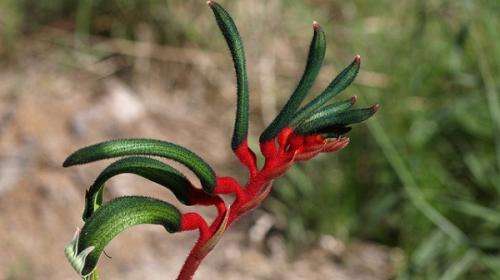Plant biodiversity under threat from general viruses

(Phys.org) —Introduced generalist plant viruses from other hosts that encounter native plant species for the first time pose a greater threat to plant biodiversity in south-west Australia than introduced specialist viruses, a recent study found.
The researchers compared impacts of six introduced generalist, seven introduced specialist and four Australian indigenous viruses on the appearance and growth of native plant species in eight families from the South West Australian Floristic region (SWAFR).
These viruses were inoculated to native plants using infective sap, but also by aphids or grafting.
Any symptoms that developed in the inoculated plants were recorded over six weeks.
UWA School of Plant Biology Professor Roger Jones says WA had no agriculture before European colonisation commenced in 1829.
He says that before then, indigenous viruses had co-evolved within the native vegetation, and were highly adapted to the plant communities they evolved in.
"The beginning of agriculture, however, saw importation of cultivated plants and weeds, which introduced new viruses along with them," he says.
"Where there are introduced crops, pastures, weeds or trees growing next to natural vegetation, viruses can move in both directions across the interface between the two.
"So, viruses move from cultivated plants to invade native plant communities growing next to them, and from natural vegetation to cultivated plants."
Prof Jones says introduced generalist viruses have the ability to invade plant species within a wide range of plant families, so they are much more likely to infect the new hosts they encounter than the specialist viruses, which are adapted to survive in only few plant species.
"The specialist viruses do little damage to the hosts that they infect naturally and often spread to the next generation through seed," he says.
"Generalist viruses are adapted to switch from one host to another, and are often very damaging to new hosts they are not well adapted to.
"When six introduced generalist viruses were inoculated to 14 native plant species from seven different families, 13 species became infected."
The researchers also found that when indigenous viruses infected native plants they were not adapted to, they caused just as much damage as the introduced generalist viruses.
Prof Jones says this is because some of the indigenous viruses used in the study were from the Kimberley (not south-west Australia) and were encountering these hosts for the first time.
While there is unique native flora in south-west Australia, Prof Jones says presently the likely endangerment of native species caused by spread of introduced viruses has received little attention.
More information: "Effects of introduced and indigenous viruses on native plants: exploring their disease causing potential at the agro-ecological interface." Vincent SJ, Coutts BA, Jones RA. PLoS One. 2014 Mar 12;9(3):e91224. DOI: 10.1371/journal.pone.0091224. eCollection 2014.
Journal information: PLoS ONE
Provided by Science Network WA
















